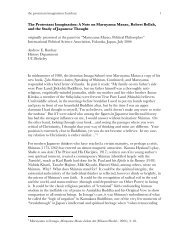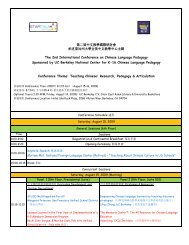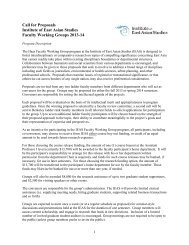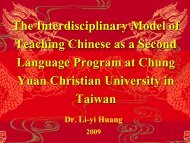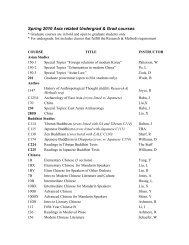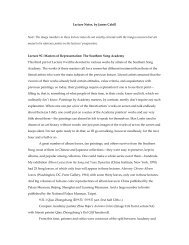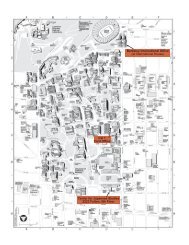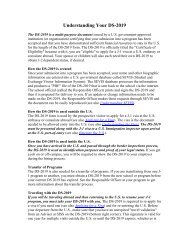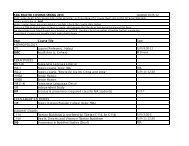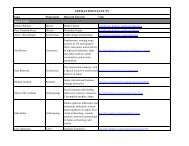Third Edition Spring 2013 - Institute of East Asian Studies, UC ...
Third Edition Spring 2013 - Institute of East Asian Studies, UC ...
Third Edition Spring 2013 - Institute of East Asian Studies, UC ...
You also want an ePaper? Increase the reach of your titles
YUMPU automatically turns print PDFs into web optimized ePapers that Google loves.
Mandarin teachers in China, Beijing is also expanding its own educationnetwork in Malaysia. As part <strong>of</strong> China’s global strategy inadvancing its “s<strong>of</strong>t power,” a Chinese government-sponsored network<strong>of</strong> educational organizations named the “Confucius <strong>Institute</strong>”has been established to teach Chinese language and promote Chineseculture worldwide. 29 In contrast to most countries where thename “Confucius” represents a school <strong>of</strong> philosophical thought, inMalaysia the word is closely associated with the religious beliefs<strong>of</strong> a certain fraction <strong>of</strong> the ethnic Chinese community in Malaysia,distinguished from ethnic Chinese Buddhists and Taoists. As a result,the Confucius <strong>Institute</strong> has experienced several unexpecteddifficulties in getting approval from the UMNO-controlled governmentto establish its branch in Malaysia, as many conservativeparty members were concerned that the institution would play arole in promoting the religion <strong>of</strong> a particular segment <strong>of</strong> ethnic Chinese.30 As a compromise, the first Confucius <strong>Institute</strong> in Malaysiahas changed its name into “Kong Zi <strong>Institute</strong> for the Teaching <strong>of</strong>Chinese Language” (KZIUM), to rid itself <strong>of</strong> the religious implications<strong>of</strong> “Confucianism.” 31More importantly, the “Kong Zi <strong>Institute</strong>” is specially tailoredto serve the non-Chinese community in Malaysia. Accordingto an unpublished document <strong>of</strong> the institute, 1104 students enrolledin its Chinese language courses in the first year (2011) <strong>of</strong>operation. 32 Malays accounted for approximately 80% <strong>of</strong> the totalnumber, whereas the percentage <strong>of</strong> Chinese and Indian studentswas 15% and 5% respectively. 33 This situation is distinct from otherChinese language training institutions in Malaysia such as thenon-Chinese government-sponsored Global Hanyu & Culture Collegeand the Mandarin Journey Language Center run by MalaysianChinese, where ethnic Chinese account for the overwhelming ma-29 The Economist, China’s Confucius <strong>Institute</strong>s: Rectification <strong>of</strong> Statues, 20 Jan2011. http://www.economist.com/node/17969895 (accessed 12/05/2012)30 Zhao Wanzhen, interview by author, 12/05/2012. Zhao Wanzhen worked as alanguage lecturer at the KZIUM from 2011 to 2012.31 “Kong Zi” is the exact Chinese pinyin spelling <strong>of</strong> “Confucius”.32 Kong Zi <strong>Institute</strong> For the Teaching <strong>of</strong> Chinese Language at University <strong>of</strong>Malaya, “Ma Da Kong Yuan PPT” (Introduction to the KZIUM), (unpublished document),06/23/201233 ibid.jority <strong>of</strong> their respective student bodies.On top <strong>of</strong> <strong>of</strong>fering courses to the public, the KZIUM activelyengages in special language training programs for Malaysiangovernment employees by cooperating with the <strong>Institute</strong> <strong>of</strong> Diplomacy& Foreign Relations (IDFR), the National Defense University(UPNM) and the Royal Malaysia Police College (RMPC). 34 Directlyinfluenced by the ethnic composition <strong>of</strong> personnel in the Malaysiangovernment, most <strong>of</strong> the participants <strong>of</strong> these programs are Malays.For example, out <strong>of</strong> 184 IDFR students who registered for languagecourses, only two were ethnic Chinese and eight were ethnic Indians.Similarly, 54 out <strong>of</strong> 55 students from the RMPC were Malays. 35According to Zhao Wanzhen, a language lecturer who worked atthe KZIUM from 2011 to 2012, there is virtually no connection betweentheir institute and local ethnic Chinese organizations whatsoever.36ConclusionMalaysia’s domestic politics is highly ethnic-based. Due toimbalances <strong>of</strong> political and economic status between the bumiputeraand non-bumiputera communities in this plural society, differentethnic groups have engaged in constant struggles to securetheir respective communal interests. Although tensions betweendifferent ethnic groups are sometimes politically manipulated, ethnicityremains a central issue in the domestic politics <strong>of</strong> Malaysia.As the second largest ethnic group in Malaysia, the Chinesecommunity plays indispensable roles in the country’s political arena.Their resilient linguistic and ethno-racial ties with China havemeant that the engagement between China and Malaysia is not aconventional state-to-state relationship. The basic pattern <strong>of</strong> Malaysia’sdomestic politics has strongly influenced its foreign policytoward China. Due to the favorable perceptions <strong>of</strong> China amongMalaysian Chinese, the Malay-controlled government has been cautiousin developing its bilateral relationship with Beijing. It needs34 Maktab Polis Diraja Malaysia35 Zhao Wanzhen, interview by author, 12/05/2012.36 Ibid.19 Kankan Xie Ethnicity And China-Malaysia Relations 20




